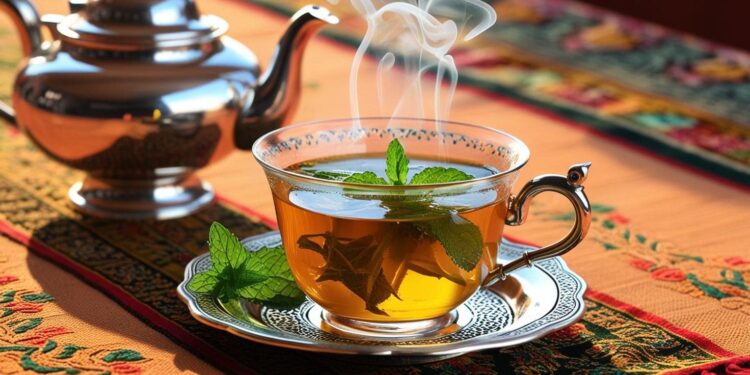In Morocco, hospitality is not just about offering food or shelter; it’s a deeply rooted tradition that encompasses warmth, respect, and connection. One of the most cherished symbols of this welcoming spirit is Moroccan mint tea. Known as Atay, this fragrant beverage is far more than a drink, it is a gesture, an art form, and a vital part of the Moroccan experience. If you’ve ever visited a Moroccan home, chances are you were offered a glass of mint tea as a sign of hospitality. But what makes this ritual so special? Let’s dive into the fascinating world of mint tea and explore how it embodies the heart of Moroccan culture.
The Symbolism Behind Moroccan Mint Tea
Mint tea holds profound significance in Moroccan culture, symbolizing generosity, unity, and respect. The ritual of serving mint tea is often seen as a way to honor the guest and create a welcoming atmosphere. The process itself, from brewing to serving, is infused with tradition and care, ensuring that the experience is memorable and meaningful.
A Drink with a Rich History
Mint tea has its roots in Moroccan history, dating back centuries. It was introduced to Morocco by the British in the 19th century, but over time, the Moroccan people embraced it, making it their own. Today, it is a staple of Moroccan life, served at virtually every social gathering, from family meals to grand celebrations. The drink consists of green tea, fresh mint leaves, and sugar, creating a perfect balance of sweetness and refreshment.
The Ritual of Preparing Moroccan Mint Tea
The preparation of Moroccan mint tea is an art that reflects the country’s attention to detail and dedication to hospitality. This ritual involves specific steps that can take up to 15 minutes, each stage contributing to the creation of the perfect cup of tea.
Step 1: Brewing the Tea
The first step involves boiling water and steeping green tea leaves, usually Gunpowder tea, which is known for its strong flavor. A common practice is to rinse the tea leaves with hot water before steeping them, removing any bitterness and ensuring a smooth taste.
Step 2: Adding Fresh Mint and Sugar
Once the tea is brewed, fresh mint leaves are added to the pot, followed by sugar to taste. The sweetness of the tea is important, as it is a symbol of the Moroccan belief that guests should always feel cared for and valued.
Step 3: Serving with Care
Moroccans take great pride in serving their mint tea. It is typically poured from a height into small glasses, allowing the tea to aerate and cool slightly. The act of serving tea with such precision and care signifies respect for the guest, and it is common to serve multiple rounds, ensuring that the guest feels welcomed and satisfied.
The Importance of Hospitality in Moroccan Culture
Hospitality is a cornerstone of Moroccan society, and mint tea plays a central role in this tradition. Whether in a bustling city or a quiet rural village, visitors are often greeted with the offer of mint tea as a gesture of goodwill. This warm reception is not just about the tea itself, but about fostering relationships and honoring one’s guest.
A Symbol of Friendship and Unity
Sharing mint tea is a social ritual that brings people together. It’s common for families and friends to gather around the tea table, exchange stories, and enjoy each other’s company. In Moroccan culture, it’s believed that the act of drinking tea strengthens bonds and fosters a sense of unity and camaraderie.
Welcoming Guests with Warmth and Generosity
When visitors arrive at a Moroccan home, they are often offered mint tea as soon as they enter. This is not merely a drink; it is an invitation to feel at home. Offering mint tea demonstrates that the host values the guest’s presence and wishes to make them feel comfortable and respected.
The Global Influence of Moroccan Mint Tea
While Moroccan mint tea is deeply ingrained in the country’s culture, it has gained international recognition as well. The sweet, aromatic drink has become a popular choice in cafes and restaurants around the world, often served alongside pastries or light meals.
Experience Moroccan Hospitality at Home
You don’t have to travel to Morocco to experience the magic of mint tea. With a few simple ingredients, you can recreate the traditional Moroccan mint tea ritual in your own home. Whether you’re entertaining guests or enjoying a quiet moment alone, mint tea offers a taste of Moroccan hospitality that can elevate any occasion.
Here’s how to make your own Moroccan mint tea:
Ingredients:
- 1 tablespoon of green tea (Gunpowder)
- 2-3 sprigs of fresh mint leaves
- 4 cups of boiling water
- 3-4 tablespoons of sugar (adjust to taste)
Instructions:
- Rinse the green tea leaves in boiling water to remove any bitterness.
- Add the tea leaves to a teapot and pour in 4 cups of boiling water. Let it steep for 5 minutes.
- Add fresh mint leaves and sugar to the teapot and stir well.
- Pour the tea into small glasses from a height to aerate and cool slightly.
- Serve with small treats and enjoy the ritual of Moroccan hospitality!
Conclusion:
Moroccan mint tea is more than just a drink, it is a reflection of the warmth, generosity, and hospitality that define Moroccan culture. By sharing a glass of mint tea, Moroccans create connections and build relationships, making each sip a meaningful experience. Whether you’re hosting friends or welcoming family, adopting this timeless ritual can help you infuse your home with the same spirit of generosity and care.
If you’re looking to learn more about Moroccan traditions or want to explore the beauty of Moroccan culture, stay tuned for more articles on the rich customs and practices that make Morocco a unique destination.










































